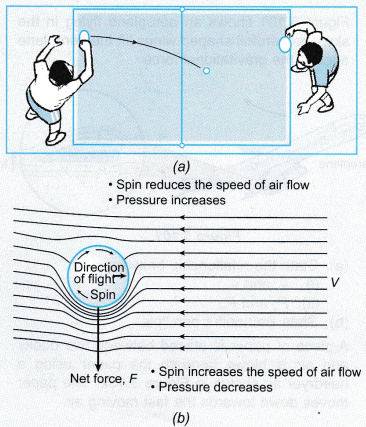Understanding Bernoulli’s Principle
- Football fans have always marvelled at how a professional footballer can execute a banana kick, sending the ball in a curved path to score a goal. Understanding the Bernoulli’s principle will help football fans to understand the scientific principle behind the curved path of the ball.
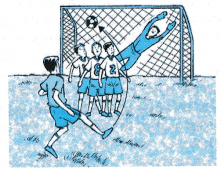
- (a) Figure (a) shows a student blowing above a thin piece of paper. The paper moves upward.
(b) Figure (b) shows a boy blowing hard with a straw into the space between two table tennis balls suspended close to each other by strings. The balls move towards each other.
(c) A fast flowing stream of air in a region results in the lowering of the air pressure in that region. This result can be explained by Bernoulli’s principle.
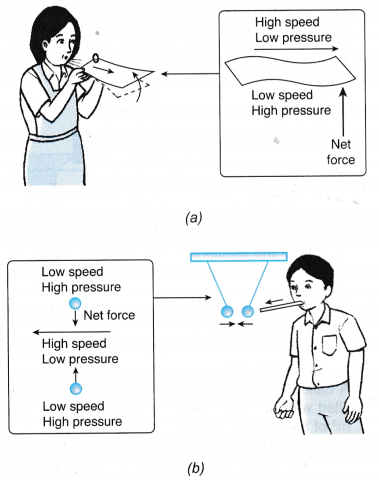
- Bernoulli’s principle states that where the speed of a fluid is high, the pressure is low; and where the speed is low, the pressure is high.
- Figure shows an activity to demonstrate Bernoulli’s principle.
(a) Water flows at a steady rate into a Venturi tube.
(b) At the narrow section of the tube, the water flows at a higher speed. As a result, its pressure decreases.
(c) Due to the decrease of pressure, the narrow section supports a shorter height of water column as shown by the vertical tube Q.
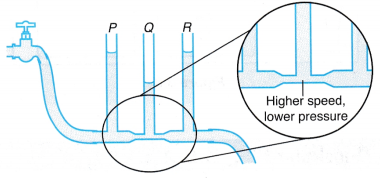
- Figure shows another activity to demonstrate Bernoulli’s principle.
(a) A hairdryer is set to blow a stream of cool air upwards. A table tennis ball is placed in the middle of the air stream.
(b) The ball stays put because air flows faster at the middle than it does at the edges. As a result, higher pressure at the edges pushes the ball back to the middle of the air stream.

Applications of Bernoulli’s Principle
Aeroplane
Figure (a) shows the aerofoil shape of the wing of an aeroplane.
 (a) When an aeroplane moves forward, air has to travel further along the curved upper surface compared with the flatter lower surface. Therefore, air moves faster at the upper surface than the lower surface.
(a) When an aeroplane moves forward, air has to travel further along the curved upper surface compared with the flatter lower surface. Therefore, air moves faster at the upper surface than the lower surface.
(b) As a result, the air pressure at the upper surface is lower than the lower surface. The difference in pressure causes a resultant force that lifts the wing upward.
Formula One Racing Car
 The low and wide body of a Formula One racing car is made of strong but light material such as carbon fibre. The sloped front end and rear spoilers are specially designed so that at high speed, the air presses down on the car to keep it from being lifted up.
The low and wide body of a Formula One racing car is made of strong but light material such as carbon fibre. The sloped front end and rear spoilers are specially designed so that at high speed, the air presses down on the car to keep it from being lifted up.
Bunsen Burner
Bernoulli’s principle explains how air is drawn into a Bunsen burner.
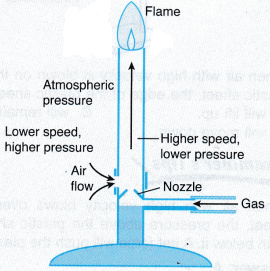 (a) The pressure of fast moving gas stream from the nozzle is less than the surrounding atmospheric pressure.
(a) The pressure of fast moving gas stream from the nozzle is less than the surrounding atmospheric pressure.
(b) The difference in pressure causes air to be drawn into the tube.
Hydrofoil Boat
An ordinary boat travels slowly on water because of the resistance of water on its hull. In contrast, a hydrofoil boat can travel much faster because its hull is lifted out of water and hence the water resistance is reduced.
 (a) Each ‘underwater wing’ or hydrofoil of the boat has a curved upper surface and a flat lower surface.
(a) Each ‘underwater wing’ or hydrofoil of the boat has a curved upper surface and a flat lower surface.
(b) This causes the water to travel at a higher speed at the upper surface than the lower surface of the hydrofoil.
(c) The pressure of the water at the upper surface is lower than the pressure at the lower surface of the hydrofoil.
(d) The difference in pressure results in a net force acting upward on the hydrofoil.
Water Pump
Figure shows a water pump which is also known as the filter pump. The function of this pump is based on Bernoulli’s principle.
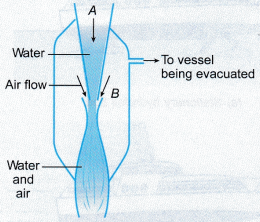 (a) A jet of water flowing from A speeds up at the nozzle and causes a reduction in the air pressure at B.
(a) A jet of water flowing from A speeds up at the nozzle and causes a reduction in the air pressure at B.
(b) Air from a vessel, which is attached to the side-
arm of the pump, is drawn out and is carried away with the water. The air from the vessel is therefore removed.
Playing tennis
Figure shows a table tennis player cut a ball while serving. This causes the ball to travel in a curved path.
(a) Cutting the ball causes it to spin.
(b) When the spin is in the same direction as the air flow, the speed of the air flow is higher. When the spin opposes the direction of the air flow, the speed of the air flow is lower.
(c) The pressure of the air moving with a higher speed is lower than that moving with a lower speed. A net force pushes the ball to the side while it is travelling forward, resulting in a curved path.
